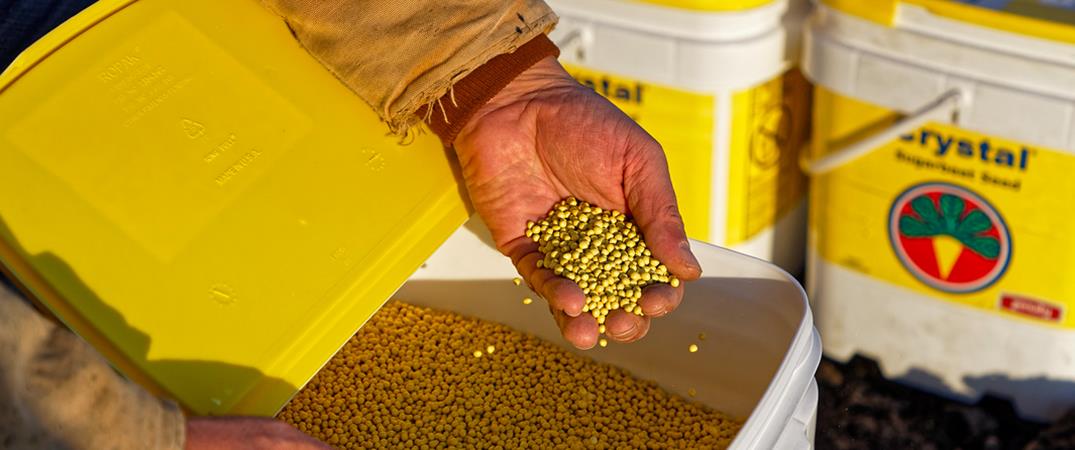
2019 OFFICIAL CODED TRIALS
A Look Back Is the Start of Forward Thinking.
Review 2019 Beet Seed Variety Trials
Review the official coded variety trial data for 2019.
Variety Selector
The Variety Selector is intended to assist growers in selecting appropriate seed varieties by identifying varieties with characteristics that are known to be consistent with the information provided by the grower.
View Official Trial Location
Results
Results from the Official Variety Trials sites were good to excellent. Stands in the trials were generally very good this year. Seven sites were used for variety approval calculations. One site was abandoned due to erratic emergence (St. Thomas) and two locations were slated to be used for Aphanomyces Specialty (Climax and Perley). However, there was not enough disease pressure to warrant Aphanomyces Specialty evaluation. Rhizoctonia was not prevalent in 2019 compared to 2018 in yield trials. Seed treatments and two applications of Quadris were used to control Rhizoctonia. Based upon susceptible plot observations, root aphids were present in low levels at eleven (11) sites. Preliminary root aphid evaluations are presented in table 6. Revenue calculations in 2019 are based on a hypothetical $44.38 payment (5-year rolling average) at 17.5% sugar and 1.5% SLM not considering hauling or production costs.
Fusarium ratings are from two Moorhead sites. The Rhizoctonia ratings are from the RRV and Michigan with the USDA. The Aphanomyces ratings are from Shakopee. The Cercospora data is from Foxhome, MN; Randolph, MN; and Michigan USDA.
The 2019 harvest conditions were challenging and unprecedented. Soil moisture levels remained above average throughout the months of September, October, and into November, combined with snow and freezing conditions, creating difficult harvest conditions in all five Factory Districts for all involved. Taking the adverse weather conditions into consideration, our OVT Harvest Staff were quite fortunate to have completed harvest at seven (7) OVT locations – those sites included Argyle, Bathgate, Casselton, Climax, Glyndon, Scandia, and Grand Forks (Conventional Trial Only). OVT site locations remaining too wet for harvest and therefore abandoned were Grand Forks, Halstad, Hillsboro, Perley, and Northcote.
The 2019 data has been combined with the previous years’ data, and results are below. Bolter data is presented in plants per acre based upon 60,000 seeds per acre. More detailed information will be printed later in the Sugarbeet Research and Extension Reports.
2020 Grower Information Includes:
- List of varieties approved for sale to ACSC growers
- Multi-year performance of RR varieties from all sites
- Performance of RR varieties under Aphanomyces conditions
- Performance of conventional varieties from three sites
- Disease ratings for all nurseries (varieties tested in 2019)
- Root Aphid rating/evaluation
- Trial sites, disease observations, and agronomic information from all trial locations
- Seed treatments applied to seed used in the official coded variety trials
2020 Grower Information (Excel)
Links to 2019 data only follow:
Plot Procedures
Yield trials were planted to stand at 4.5 inches. Plots were planted crosswise (90°) to the cooperators’ normal farming operations, where possible. Plot row lengths for all official trials were maintained at 46 feet with about 39 feet harvested. Planting was performed with a 12-row SRES vacuum planter. The GPS controlled planter gave good single seed spacing which facilitated emergence counting. Seed companies had the option of treating seed with Tachigaren, insecticide, and a Rhizoctonia seed treatment fungicide. Emergence counts were taken on 24 feet of each plot. Multiple seedlings were counted as a single plant if they emerged less than 1 inch apart. The stands in all yield trials were refined by removing doubles (multiple seedlings less than 1.5 inches apart) by hand but were not further reduced.
Roundup Powermax with Event and full rates of fungicides were applied using a pickup sprayer driven down the alleys. Hand weeding was used where necessary. The micro rate program was used on conventional trials. All yield trials were treated with Quadris in a band during the 2 leaf (9 oz) and 6-10 leaf stage (14 oz) for Rhizoctonia control. Azteroid was applied at the plant at Casselton. Treatments used for Cercospora control in 2019 included Inspire XT/Penncozeb, Agri Tin/Incognito, Proline/Penncozeb, and Headline/Agri Tin. Ground spraying was conducted by ACSC technical staff.
RR varieties with commercial seed were planted in four-row, six replication trials. The RR experimental entries were planted in smaller two-row, four replication trials. Two applications of Roundup were made in the 4-6 (32 oz) and 8-12 (22 oz) leaf stages.
All plot rows were measured for total length after approximately 3.5 feet at each end were removed at the end of August, with skips greater than 60 inches being measured for adjustment purposes. New in 2019, harvest was performed with one customized six-row harvester (Big Red) with increased cleaning capacity. All harvested beets of each plot were used for yield determination while one sample (approx. 25 lb.) for sugar and impurity analysis was obtained from each plot. Quality analysis was performed at the ACSC Technical Services quality lab in Moorhead.
Varieties were planted in disease nurseries in North Dakota, Minnesota, and Michigan to evaluate varieties for disease tolerance.
ACSC adjusts the Cercospora, Aphanomyces, Rhizoctonia, and Fusarium nursery data each year to provide a consistent target for variety approval criteria.
Before purchasing seed, please check to make sure the varieties you are buying are on the current approved list. In accordance with the grower contract, the cooperative has the option to refuse beets of a non-approved variety. If you have questions, please contact the ACSC Technical Services Center or your ACSC Agriculture Department.
